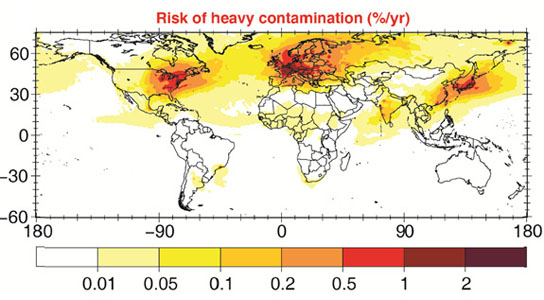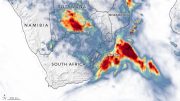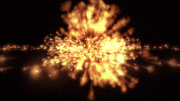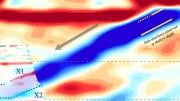
Global risk of radioactive contamination. The map shows the annual probability in percent of radioactive contamination by more than 40 kilobecquerels per square meter. In Western Europe the risk is around two percent per year. Credit: Daniel Kunkel, MPI for Chemistry, 2011
Based on new calculations from scientists at the Max Planck Institute, the likelihood of a nuclear accident is far greater than previously thought. The research shows that nuclear accidents, such as core meltdowns, may occur every 10 to 20 years, 200 times more often than estimated in the past.
Catastrophic nuclear accidents such as the core meltdowns in Chornobyl and Fukushima are more likely to happen than previously assumed. Based on the operating hours of all civil nuclear reactors and the number of nuclear meltdowns that have occurred, scientists at the Max Planck Institute for Chemistry in Mainz have calculated that such events may occur once every 10 to 20 years (based on the current number of reactors) — some 200 times more often than estimated in the past. The researchers also determined that, in the event of such a major accident, half of the radioactive caesium-137 would be spread over an area of more than 1,000 kilometers (620 miles) away from the nuclear reactor. Their results show that Western Europe is likely to be contaminated about once in 50 years by more than 40 kilobecquerel of caesium-137 per square meter. According to the International Atomic Energy Agency, an area is defined as being contaminated with radiation from this amount onwards. In view of their findings, the researchers call for an in-depth analysis and reassessment of the risks associated with nuclear power plants.
The reactor accident in Fukushima has fueled the discussion about nuclear energy and triggered Germany’s exit from their nuclear power program. It appears that the global risk of such a catastrophe is higher than previously thought, a result of a study carried out by a research team led by Jos Lelieveld, Director of the Max Planck Institute for Chemistry in Mainz: “After Fukushima, the prospect of such an incident occurring again came into question, and whether we can actually calculate the radioactive fallout using our atmospheric models.” According to the results of the study, a nuclear meltdown in one of the reactors in operation worldwide is likely to occur once in 10 to 20 years. Currently, there are 440 nuclear reactors in operation, and 60 more are planned.
To determine the likelihood of a nuclear meltdown, the researchers applied a simple calculation. They divided the operating hours of all civilian nuclear reactors in the world, from the commissioning of the first up to the present, by the number of reactor meltdowns that have actually occurred. The total number of operating hours is 14,500 years, the number of reactor meltdowns comes to four—one in Chernobyl and three in Fukushima. This translates into one major accident, being defined according to the International Nuclear Event Scale (INES), every 3,625 years. Even if this result is conservatively rounded to one major accident every 5,000 reactor years, the risk is 200 times higher than the estimate for catastrophic, non-contained core meltdowns made by the U.S. Nuclear Regulatory Commission in 1990. The Mainz researchers did not distinguish ages and types of reactors, or whether they are located in regions of enhanced risks, for example by earthquakes. After all, nobody had anticipated the reactor catastrophe in Japan.
25 percent of the radioactive particles are transported further than 2,000 kilometers
Subsequently, the researchers determined the geographic distribution of radioactive gases and particles around a possible accident site using a computer model that describes the Earth’s atmosphere. The model calculates meteorological conditions and flows, and also accounts for chemical reactions in the atmosphere. The model can compute the global distribution of trace gases, for example, and can also simulate the spreading of radioactive gases and particles. To approximate the radioactive contamination, the researchers calculated how the particles of radioactive caesium-137 (137Cs) disperse in the atmosphere, where they deposit on the earth’s surface and in what quantities. The 137Cs isotope is a product of the nuclear fission of uranium. It has a half-life of 30 years and was one of the key elements in the radioactive contamination following the disasters of Chernobyl and Fukushima.
The computer simulations revealed that, on average, only eight percent of the 137Cs particles are expected to deposit within an area of 50 kilometers around the nuclear accident site. Around 50 percent of the particles would be deposited outside a radius of 1,000 kilometers, and around 25 percent would spread even further than 2,000 kilometers (1,240 miles). These results underscore that reactor accidents are likely to cause radioactive contamination well beyond national borders.
The results of the dispersion calculations were combined with the likelihood of a nuclear meltdown and the actual density of reactors worldwide to calculate the current risk of radioactive contamination around the world. According to the International Atomic Energy Agency (IAEA), an area with more than 40 kilobecquerels of radioactivity per square meter is defined as contaminated.
The team in Mainz found that in Western Europe, where the density of reactors is particularly high, the contamination by more than 40 kilobecquerels per square meter is expected to occur once in about every 50 years. It appears that citizens in the densely populated southwestern part of Germany run the worldwide highest risk of radioactive contamination, associated with the numerous nuclear power plants situated near the borders between France, Belgium and Germany, and the dominant westerly wind direction.
If a single nuclear meltdown were to occur in Western Europe, around 28 million people on average would be affected by contamination of more than 40 kilobecquerels per square meter. This figure is even higher in southern Asia, due to the dense populations. A major nuclear accident there would affect around 34 million people, while in the eastern USA and in East Asia this would be 14 to 21 million people.
“Germany’s exit from the nuclear energy program will reduce the national risk of radioactive contamination. However, an even stronger reduction would result if Germany’s neighbors were to switch off their reactors,” says Jos Lelieveld. “Not only do we need an in-depth and public analysis of the actual risks of nuclear accidents. In light of our findings I believe an internationally coordinated phasing out of nuclear energy should also be considered,” adds the atmospheric chemist.
Reference: “Global risk of radioactive fallout after major nuclear reactor accidents” by J. Lelieveld, D. Kunkel and M. G. Lawrence, 12 May 2012, Atmospheric Chemistry and Physics.
DOI: 10.5194/acp-12-4245-2012









This is an asinine paper – it assumes we learn nothing from the past. The Chernobyl core meltdown was a direct result of the fact that the RBMK type reactor uses a graphite moderator. Solution? Don’t use graphite as a moderating material. The Fukushima meltdown was a direct result of the backup generators for the emergency core coolant system being swamped by a tsunami. Solution? Don’t locate your backup generators where they can be flooded by coastal waters. It isn’t correct that these problems weren’t recognized beforehand – poor project management just swept the problems under the rug. Reactor design and operation is improving with experience and there is no reason to assume that the future will just be a repeat of the past. I suspect that this paper is greatly coloured by the current political situation in Germany with respect to nuclear power.
Fukushima had back up generators behind walls calculated to take on the tsunami risk the site was expected to get in approximately 1000 years. Oops. They had about four assumptions proven incorrect, not least being the main backup of overhead towerlines which fell over from the preceding major earthquake.
“The Mainz researchers did not distinguish ages and types of reactors, or whether they are located in regions of enhanced risks”
So the risk of an accident in a seismically active area like Japan is assumed to be the same as in Germany? Asinine is right.
Max Planck Institute??? Are you sure it wasn’t the green party – greenpeace. That paper is an insult to Max Planck. Have these people tried to find out how much money was spent to prevent a future incident like that? I am sure they have factored in the all too frequent Tsunamis in Bavaria.
There is vastly more radioactive emmissions coming from the greens favorite backup energy source, brown coal. Coal is loaded with uranium, it was even lightly considered as a source of uranium in the early days. There is more energy in the uranium in coal than in burning the coal. At least nuclear power keeps the radioactive waste on the ground while green brown coal lofts it into the atmosphere for all to breath.
Germans are wierd, they justify shutting down half their reactor fleet because of nonexistent tsunami threat to Germany to replace with intermittent energy that is backed up by new gen fast turn on coal burners ie peakers. So their carbon emmissions never went down and never will. They still have 8 or so large reactors they promised to shut down by 2022. I dare them to so we can see how much more hypocrisy they they can muster.
The UK doesn’t blab so much about green energy so much because it is a hard problem. They use about 2/3 of German energy per capita but at the same time have half the CO2 emmisions per capita. So Germany leads the UK in CO2 release per TJ of energy produced even though it is covered in solar and wind but lots of brown coal.
Asinine is right.
And of course Molten Salt Reactor have none of the major weaknesses of PWRs, no pressure, the waste products are dissolved in the very hot salts, the xenon and krypton gasses can bubble out of liquid salts to be collected, and so on. They also can be nearly twice as efficient since the high temperature means high carnot efficiency and potential use of hot salt for industrial use, ie splitting water etc. Even load following is made easier with hot salt storage and generate power much higher or lower than heat production rate.